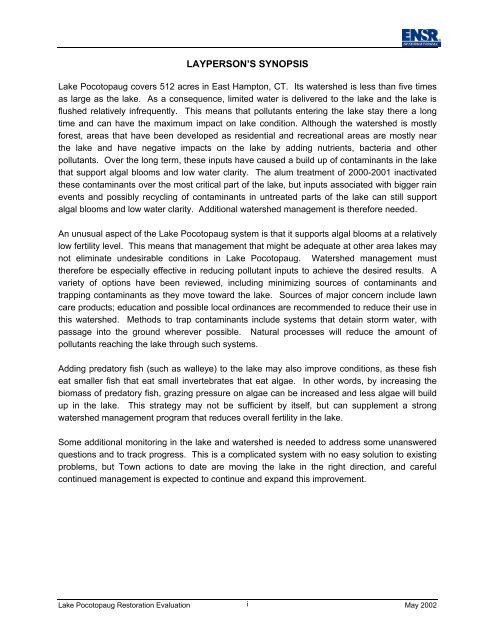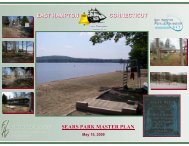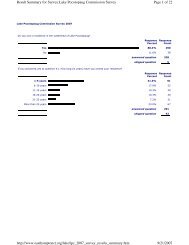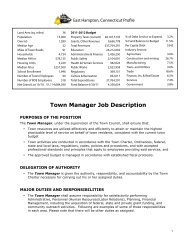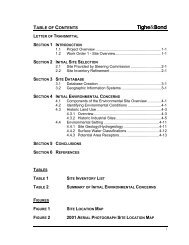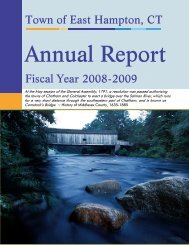Lake Pocotopaug Lake and Watershed Restoration Evaluation ...
Lake Pocotopaug Lake and Watershed Restoration Evaluation ...
Lake Pocotopaug Lake and Watershed Restoration Evaluation ...
You also want an ePaper? Increase the reach of your titles
YUMPU automatically turns print PDFs into web optimized ePapers that Google loves.
LAYPERSON’S SYNOPSIS<strong>Lake</strong> <strong>Pocotopaug</strong> covers 512 acres in East Hampton, CT. Its watershed is less than five timesas large as the lake. As a consequence, limited water is delivered to the lake <strong>and</strong> the lake isflushed relatively infrequently. This means that pollutants entering the lake stay there a longtime <strong>and</strong> can have the maximum impact on lake condition. Although the watershed is mostlyforest, areas that have been developed as residential <strong>and</strong> recreational areas are mostly nearthe lake <strong>and</strong> have negative impacts on the lake by adding nutrients, bacteria <strong>and</strong> otherpollutants. Over the long term, these inputs have caused a build up of contaminants in the lakethat support algal blooms <strong>and</strong> low water clarity. The alum treatment of 2000-2001 inactivatedthese contaminants over the most critical part of the lake, but inputs associated with bigger rainevents <strong>and</strong> possibly recycling of contaminants in untreated parts of the lake can still supportalgal blooms <strong>and</strong> low water clarity. Additional watershed management is therefore needed.An unusual aspect of the <strong>Lake</strong> <strong>Pocotopaug</strong> system is that it supports algal blooms at a relativelylow fertility level. This means that management that might be adequate at other area lakes maynot eliminate undesirable conditions in <strong>Lake</strong> <strong>Pocotopaug</strong>. <strong>Watershed</strong> management musttherefore be especially effective in reducing pollutant inputs to achieve the desired results. Avariety of options have been reviewed, including minimizing sources of contaminants <strong>and</strong>trapping contaminants as they move toward the lake. Sources of major concern include lawncare products; education <strong>and</strong> possible local ordinances are recommended to reduce their use inthis watershed. Methods to trap contaminants include systems that detain storm water, withpassage into the ground wherever possible. Natural processes will reduce the amount ofpollutants reaching the lake through such systems.Adding predatory fish (such as walleye) to the lake may also improve conditions, as these fisheat smaller fish that eat small invertebrates that eat algae. In other words, by increasing thebiomass of predatory fish, grazing pressure on algae can be increased <strong>and</strong> less algae will buildup in the lake. This strategy may not be sufficient by itself, but can supplement a strongwatershed management program that reduces overall fertility in the lake.Some additional monitoring in the lake <strong>and</strong> watershed is needed to address some unansweredquestions <strong>and</strong> to track progress. This is a complicated system with no easy solution to existingproblems, but Town actions to date are moving the lake in the right direction, <strong>and</strong> carefulcontinued management is expected to continue <strong>and</strong> exp<strong>and</strong> this improvement.<strong>Lake</strong> <strong>Pocotopaug</strong> <strong>Restoration</strong> <strong>Evaluation</strong> iMay 2002


